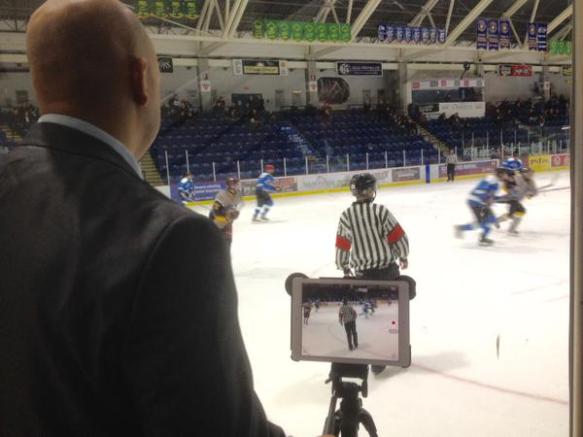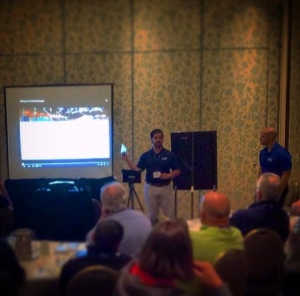
BC Hockey Referee-in-Chief Sean Raphael using Coach’s Eye at the 2014 RBC Cup in Vernon, BC. Photo via twitter.com/BCHockey_Refs
Over the last several decades, video technology has fundamentally altered the way that we experience the game of hockey. In the modern era, a game isn’t broadcast on television without every play available for replay from six different angles in super-slow motion. The use of video in hockey has become ubiquitous to the point that there isn’t a PeeWee team that doesn’t utilize regular video sessions as part of their player development. However, video has yet to penetrate the officiating side of the sport to the same degree. Unfortunately, both in the professional and minor spheres, the most frequent use of video has been to catch officials making mistakes. However, from the perspective of developing officials, feedback is only useful if it’s constructive. Simply pointing out every instance where an official missed a trip, slash, or check from behind doesn’t meet the criteria.
This is not to say that video doesn’t have a place in the development of officials at the minor and junior levels. Video coaching is a tool that has massive upside for officiating development when utilized in a limited context. From the beginning of this experiment, my use of video has focused on the procedural aspects of officiating that are difficult to explain in isolation and would benefit from having a video example. I have absolutely avoided using video to discuss individual calls or non-calls by an official. I avoid isolating individual calls for the same reason that everyone who watches the NHL and has a Twitter account thinks they could referee. It’s simply too easy for a supervisor to spend several minutes zooming in, slowing down, and replaying an incident until they come to a decision that the official on the ice had to make in a split-second. Furthermore, my experiment has focused almost exclusively on minor officials, albeit at the higher levels of minor hockey. Therefore, I have scrupulously avoided giving officials the impression that my presence at the rink is to catch them doing something wrong. A supervisor isn’t doing an official any favours if the official feels like the supervisor is “nit-picking” at their performance. The singular objective is for the official to feel that they’re being provided with an additional dimension to enhance their learning and development.
From a supervisor’s perspective, the one drawback of utilizing video coaching is that, in minor hockey, the supervisor has to shoot the video themselves. The reality is that when a supervisor is shooting video of an official, they’re not really watching the game. This means that their ability to talk to the official about their overall performance is diminished. An additional consideration is that most minor hockey associations have very limited resources devoted to officiating development. In most cases, supervisory work is either done on a strictly volunteer basis or their budget for remunerating supervisors is restrictive. Given these constraints, it doesn’t make sense for a supervisor to spend the entire game filming when it’s one of only a few opportunities to develop a particular official that season. With that in mind, I will only utilize video coaching under the following conditions:
1) The official being supervised is working at least Bantam AAA and/or this is a high performance event (Provincial Championship, U16 Cup, etc.)
2) The supervisor has previously supervised the official during the current season
3) The supervisor identifies an aspect of the official’s game that would benefit from video coaching after having watched at least one full period
If a situation meets these requirements, it means that the supervisor already has some kind of relationship with the official and the official is presumably mature enough to handle highly specific, individual feedback. It also indicates that the supervisor has a good idea of how the official is reacting within the game before committing both their time and the official’s to video coaching. The point of these guidelines is to ensure a judicious use of video coaching, which is necessary in order to be beneficial in minor officiating.

Dan delivering a presentation on video coaching to the Officiating Seminar at the 2015 BC Hockey Annual General Meeting.
Once the video has been collected, the question remains of how best to deliver the feedback to the officials in question. Thus far, use of video coaching at the Above Minor level in BC Hockey has taken a more immediate approach; either reviewing video in the dressing room post-game or simply emailing a raw video clip of the incident in question to the official. However, post-production utilizing video analysis tools provided by Coach’s Eye* allows for greater flexibility in addressing the unique challenges of developing minor hockey officials. Given the reality of back-to-back games and parents giving rides to and from the rink, supervisors already feel pressed for time when conferring post-game with their officials. Adding the element of video review and discussion is simply not feasible under this paradigm and post-production provides freedom for extensive explanation that a minor official is likely to require.
The addition of post-production elements to video coaching is also beneficial because it creates a record of feedback for that official. Video feedback functions in the same way as a traditional supervision, whether a paper form or electronically through the Hockey Canada Registry. Video feedback can be valuable to an official even when revisited long after the game in question. Post-production also allows supervisors to distribute a single clip to multiple officials as a developmental tool. The use of the voice-over and visual analysis tools means that the clip can be distributed as a self-contained unit, without requiring any additional explanation.
I began to use video coaching in this way when I was given the opportunity to supervise the 2015 PeeWee Female Provincial Championship. Earlier that season, I had recorded a clip from a Juvenile A game that was an excellent example of linesmen communicating and switching lines on the fly. The linesman working the game would not benefit from reviewing the clip, as they were both experienced officials for whom this was an ingrained aspect of their game. However, at the PeeWee Female Championships, I was working with young Level II and older Level I officials who were on the cusp of making the transition to higher levels of minor hockey. The awareness and communication required between linesmen to switch lines on the fly was not yet second-nature to these officials. Utilizing the voice-over and visual analysis tools of Coach’s Eye, I created a minute-long clip that broke down the process of switching lines on the fly. Not only was I able to distribute the video to all fourteen officials working the tournament, but I can also share it with officials in the future as a quick and easy example of the kind of awareness and communication required for the transition into the higher levels of minor hockey. Once a supervisor has acquired quality video, it is simple and easy to ensure that every official receives the same message on a given aspect of officiating.
Video technology has already changed how we view the game of hockey and will continue to permeate every level of the sport over the next few years. The question is how supervisors can turn technology to our advantage as we continue developing officials. A judicious use of video coaching in minor officiating with a focus on the procedural aspects of officiating will fundamentally change the relationship between officials and video technology.
*This article is not an advertisement for Coach’s Eye, which is a tool that I purchased through the Apple App Store. Coach’s Eye is just one of many video coaching apps available for Apple and Android devices.
Dan is a Level IV Hockey Canada referee, officiating in the BCHL, PJHL, and BCMML. Since 2011, he has been serving as the Assistant Referee-in-Chief for the Vancouver Thunderbird Minor Hockey Association. He has also had the privilege of being an HCOP Course Conductor since 2013 and a BC Hockey Minor Supervisor since 2013, supervising 3 BC Hockey Provincial Championships, instructing 4 BC Hockey Summer Officiating Schools.
